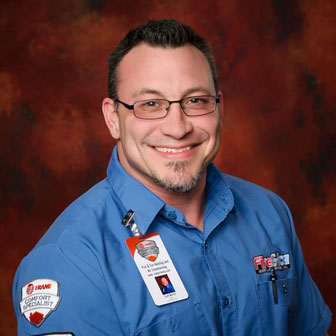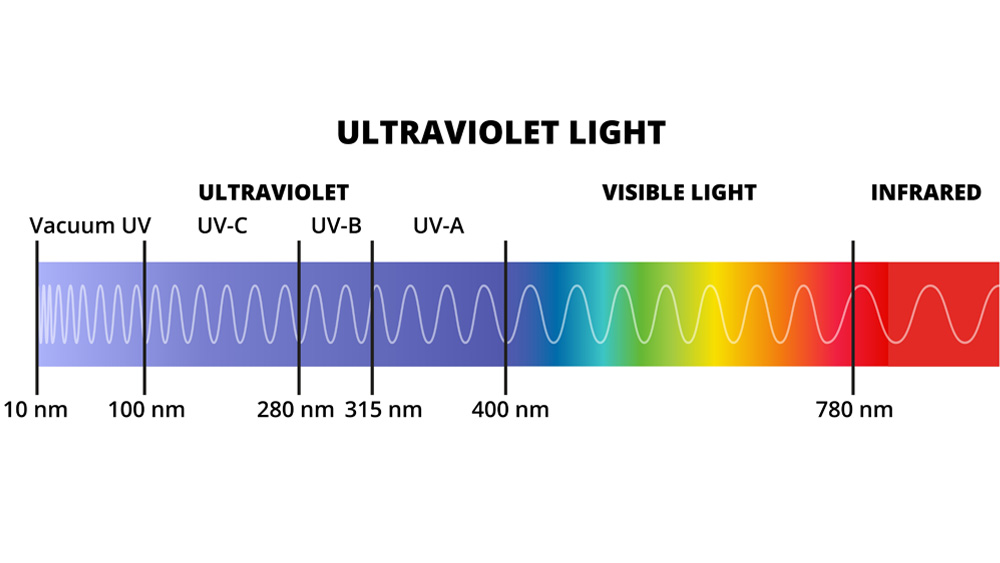


Author:
Revised:
March 9th, 2023
As our world continues to evolve and adapt, so do humans and the technology we use daily. The concept of UV lights within HVAC systems is a phenomenon that has been around for a while. In fact, using UV lights as a disinfectant dates back to the 1800s, with one of their first implementations in hospitals in 1930.
By the 1960s, UV lights were being used everywhere, including meat storage and processing plants, bakeries, breweries, and pharmaceutical plants, basically anywhere that microbiological contamination could be a grave concern.
Today, you can have your home HVAC system equipped with UV technology to purify the air in your home and improve your home's indoor air quality.
At Fire and Ice, we are stocked with the latest and greatest HVAC technologies, including UV lighting and installation. Keep reading to determine if a residential UV light is right for you and the comfort of your home.
In this article, we will cover several aspects of UV Lights, including:
- What is an HVAC UV Light?
- Upsides and Downsides of UV Lights
- HVAC Products with UV Technology
- Does the Cost Outweigh the Benefits?
- What are the Next Steps?
Let's dig in!
What is an HVAC UV Light?
First thing first, what does "UV" stand for? That's right! Ultraviolet - see, you're already halfway there! There are three types of UV lights, including UVA, UVB, and UVC; however, in this article, we will only focus on UV C light.
How Do HVAC UV-C Lights Work?
This type of UV lighting uses the “C” wavelength. UVC lights are the shortest and most germicidal UV wavelength within the UV spectrum.
These germicidal UV lights are used in tandem with your HVAC system, which is generally installed directly into your air handler (if you have one) or your ductwork. So, as the unwanted particles move through your central air conditioning system, the UV lamp will stop and eradicate them.
Once the unwanted germs and bacteria are hit with the germicidal UV rays, it disrupts the microorganism's DNA. When the DNA of the microorganism is disrupted, it cannot reproduce. Thus, killing them before they are integrated back into your home's air cycle.

Types of Sanitizing Lights
Not only are there different classes of UV lights, but there are also two types of sanitizing lights: coil and air. Both are effective; below are the functions and features of each to help you determine which UV light would be right for you, your home, and your comfort.
Coil Sanitizing Lights:
This type of ultraviolet light is typically a long and thin fluorescent light, which is usually the more common and cost-effective option. They are commonly placed above or in line with the evaporator coil, which works as a coil sterilization that prevents mold, bacteria, and fungi from forming in/or around the coil.
Coil UV lights purify the air as it moves through your HVAC air cycle. However, since this type of UV light isn’t directly wired to your residential HVAC system, the UV lights are generally on 24/7.
Air Sanitizing Lights:
Like the Coil Sanitizing lights, the UV bulbs for air sanitizing are long and thin; however, they can also be in the shape of a horseshoe. These lights are commonly more expensive, but they are typically better quality overall.
They are usually installed in your return air duct (which sucks the air from each room) and they purify the air before it makes its way to your HVAC system. This type of UV light is directly wired to your HVAC system, so it turns on only when your system is in use, thus making this version more energy efficient.
Homeowners who typically opt for air-sanitizing UV lights are homeowners who have loved ones who suffer from allergies or other respiratory issues.
If you are concerned about improving indoor air quality in your home, you can get by with a coil-sanitizing light. On the other hand, if you are a homeowner concerned about his/her indoor air quality, as well as any allergies or respiratory infections, then air-sanitizing lights have better air-cleaning capabilities, which, in turn, will give you a greater sense of relief.
Upsides and Downsides of Using UV Lights
As with everything in our world, there are upsides and downsides when implementing UV lights into your HVAC system. However, at Fire and Ice, we believe that the upsides outweigh the downsides.
So, what are they?
Upsides to UV Lights
- 99% effective at removing germs, bacteria, and even Covid-19
- Better airflow
- Improves your HVAC systems’ efficiency
- Energy-efficient and can reduce your monthly utility bills
- Less clogging in drain lines
- Virtually silent - you won’t know it’s running
- A non-intrusive option for cleaner air
- Consistently self-cleaning
- Can minimize odors
- Protection from allergies, germs, diseases, bacteria, mold, mildew, and more!
Downsides to UV Lights
- More effective when paired with another air filtration device
- Requires UV light contact to neutralize bacteria and odors
- Replacement bulbs are a repeated cost and should be changed at least once every one to two years
- Bulbs are expensive, starting at $100
- They still require maintenance
- Depending on the bulb used, it can create ozone
HVAC Products with UV Technology:
As homeowners are starting to care more about the quality of air inside their homes, more HVAC brands are trying to make the leap forward and offer or invent UV light systems for their heating and cooling systems.
Reme Halo:
The Reme Halo UV air purifier is one of the leading innovators using UV lights for air purification. Reme also has an LED version of an in-duct air purifier. While they are two different products, the underlying technology and their purification process are virtually identical.
The Reme Halo products can neutralize several air pollutants, including, but not limited to, unwanted or musty odors, airborne and surface bacteria, certain allergy triggers, and even Covid-19.
Related Content: Reme Halo Air Purifier & COVID-19: Proven Effective Against Coronavirus
It works by incorporating vaporized hydrogen peroxide into your home's ducts, which then acts as an air sterilization to eliminate viruses, germs, bacteria, and other unwanted particles living in your home.
Halo-LED:
The creators of the Reme Halo have taken their design and residential air purification to the next level. This new generation of the Reme Halo is made to purify every bit of air that makes it through your home's HVAC cycle. It combats against the three known causes of indoor air pollution, particulates, microbial, and gasses.
According to the RGF Environmental Group, the Reme Halo-LED equipment turns on and off with your system's blower and typically has a longer lifespan than the Reme Halo. On top of that, it has greater energy efficiency and zero ozone creation, which is a win for you and the environment!

The Reme Halo or Halo LED is perfect for homeowners who care about their home's indoor air quality. They typically run for around $1,000, which includes professional installation. Remember that pricing may change due to the size and scope of your home and your current HVAC system.
Also, just like any other HVAC part, the Reme Halo and LED requires maintenance and replacing the UV bulb. The UV bulb is typically changed once every year or two, and on average, a new UV bulb costs about $450.
Also Read: The Reme Halo Air Purifier: Take Control of Your Home Air Quality
Carrier: Ultraviolet Single or Dual Germicidal Lamps
Another UV germicidal lamp on the market is the Carrier Ultraviolet (UV) Lamp. This add-on Carrier product comes with either one or two lamps that are inserted into the air ducts of your HVAC system.

As air passes through the cooling coil of your HVAC unit, unwanted airborne pathogens, such as mold spores, bacteria, and fungi, will stick to the damp and dark surfaces of your ductwork. Any build-up on these surfaces can result in poor system performance and unwanted odors.
This HVAC UV light system is mounted by the cooling coil and is designed to eliminate any unwanted impurities from being cycled back into your home’s clean and conditioned air. Other traditional cleaning methods include chemicals or steam, while the Carrier UV Lamp is less invasive and has more energy efficiency than other IAQ products.
The Carrier Ultraviolet lights require little to no maintenance and no cleaning. Carrier has a 10-year parts limited warranty with proper registration and a 90-day limited warranty for bulbs. One thing to remember is that these lamp bulbs are self-cleaning; however, they must be replaced about once a year.
Can I Install a UV Light Myself?
While I know that DIYing this piece of HVAC equipment seems easy and there are several online videos showing you how to do so, UV lights can be very dangerous and should be installed by a professional. As mentioned above and by the FDA, ultraviolet-c has a high level of radiation and can cause injury to the skin, eyes, or both.
Not only can it be physically dangerous, but installing a UV light yourself requires holes in your existing ductwork, which, if done incorrectly, can damage your HVAC system, turning a $1,000 home project into a $10,000 project.
Therefore, if you don’t have any HVAC knowledge or experience installing UV lights into your existing HVAC system, it’s best to leave it to the professionals.
Does the Cost Outweigh the Benefits?
Now, you may wonder if the cost of a UV light outweighs the benefits; our answer is a resounding YES! But ultimately, it comes down to investing in your home's comfort and overall indoor air quality.
This is especially true if you have someone in your home who has allergies, respiratory issues, or even someone who is immunocompromised. Installing a UVC light may be the answer you're looking for.
Investing in a UV light can keep problem particles at bay and away from the air you breathe. It can also keep your heating and cooling system running smoothly for many years down the road.
What are the Next Steps?
Do you want to step your home's indoor air quality to the next level? Fill out the form below to see if you're in our service area and get one step closer to breathing easier!




























